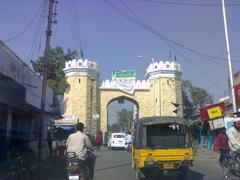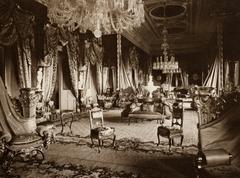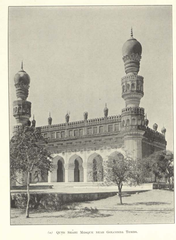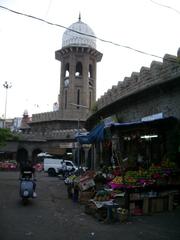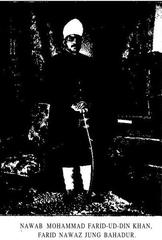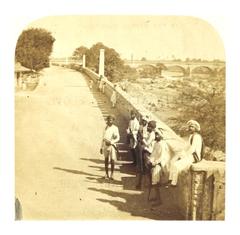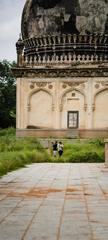Telangana High Court Visiting Hours, Tickets, and Historical Significance in Hyderabad
Date: 14/06/2025
Introduction
Perched along the southern bank of the Musi River, the Telangana High Court is a beacon of judicial authority and a testament to Hyderabad’s rich heritage. Established in 1919 under the 7th Nizam, His Exalted Highness Mir Osman Ali Khan, the court marked a significant advancement in the region’s legal framework, establishing the separation of powers well before it became a constitutional mandate in India (tshc.gov.in). Its Indo-Saracenic architectural style, a confluence of Mughal, Persian, and European influences, reflects the cosmopolitan spirit of Hyderabad and the vision of the Nizam era (thenewsminute.com).
Over the last century, the High Court has witnessed Hyderabad’s evolution from a princely state through integration into the Indian Union, the Andhra Pradesh era, and finally to its role as the apex court of Telangana since 2019. Today, it stands not just as a legal institution but also as a cultural landmark, attracting tourists, heritage enthusiasts, and legal professionals alike (telanganatourism.gov.in; tshc.gov.in).
This comprehensive guide explores the Telangana High Court’s origins, architectural marvels, visiting hours, ticket policies, accessibility features, nearby attractions, and practical visitor tips, ensuring a rewarding experience for anyone keen to discover Hyderabad’s legal and architectural legacy.
Table of Contents
- History and Establishment
- Architectural Significance
- Political and Legal Evolution
- Role in Judicial and Civic Life
- Heritage Status and Conservation
- Visitor Information
- Frequently Asked Questions (FAQ)
- Milestones and Notable Events
- Future Developments
- Plan Your Visit
- References
History and Establishment
The Telangana High Court, originally the High Court of Hyderabad, was inaugurated in 1919 by the 7th Nizam as an essential part of judicial reforms for the Hyderabad State (tshc.gov.in; theislamicheritage.com). Its establishment formalized the separation of judiciary from the executive, a progressive model for its time.
The court began with six judges and was notable for its independence and modern legal procedures, setting a precedent that would later be embraced throughout India.
Architectural Significance
Style and Influences
The Telangana High Court is a prime example of Indo-Saracenic architecture, blending Mughal, Persian, and European elements. Notable for its grand domes, minarets, and decorative jali work, the building exemplifies the “Osmanian” architectural style unique to Hyderabad (thenewsminute.com; Treebo). The design was executed under the guidance of British architect Vincent J. Esch, Shankarlal of Jaipur, and local architect Mehar Ali Fazil (Reddit).
Materials and Layout
Constructed with pink granite and red sandstone, the High Court’s color palette ensures both durability and visual appeal. The building sits on a 9-acre site, originally designed for six judges but expanded over time to accommodate the increasing needs of the judiciary (The News Minute).
Notable Features
- The massive central dome and subsidiary domes provide ventilation and light.
- The main arch, considered among the largest Indo-Saracenic arches in India, stands out for its scale.
- Intricate jali screens and ornamental stonework adorn windows and balconies.
- Strategic placement of windows ensures ample natural light, especially striking at sunset (Treebo).
Political and Legal Evolution
- Nizam Era (1919–1948): The court functioned as the highest judicial body in Hyderabad State, pioneering modern legal processes.
- Integration into Indian Union (1948–1956): After Hyderabad’s accession to India, the court’s jurisdiction merged with the Indian judiciary, and pending appeals were transferred to the Supreme Court (tshc.gov.in).
- Andhra Pradesh Era (1956–2014): Following state reorganization, the High Court served Andhra Pradesh, expanding its capacity.
- Telangana Era (2019–Present): With Telangana’s formation, the court became the exclusive High Court for the new state (theislamicheritage.com).
Role in Judicial and Civic Life
The Telangana High Court is the highest court in the state, adjudicating civil, criminal, and constitutional matters. It has produced several prominent jurists who have served in the Supreme Court of India, contributing significantly to the nation’s legal landscape (tshc.gov.in). The building’s golden jubilee in 2006 and centenary celebrations in 2019 attest to its cultural and civic significance.
Heritage Status and Conservation
Recognized as a heritage monument, the High Court is protected under conservation laws and represents a crucial part of Hyderabad’s historical identity (hyderabadtourism.travel). Ongoing restoration efforts aim to balance preservation with the requirements of a modern judiciary (The Hindu).
Visitor Information
Visiting Hours
- The High Court is open to visitors from 9:30 AM to 5:00 PM, Monday to Friday. It is closed on weekends and public holidays.
- Exterior viewing is permitted during these hours. Interior access is restricted except for authorized individuals or special occasions (My Visiting Hours).
Entry and Tickets
- Entry is free; no tickets are required.
- All visitors must pass through security screening and show valid photo identification.
- Photography is permitted outside but not within courtrooms or restricted areas.
Accessibility
- Ramps and accessible pathways are available, but some areas may still pose challenges due to the building’s historic nature.
- Ongoing improvements aim to enhance accessibility for differently-abled visitors (Deccan Chronicle).
Guided Tours and Tips
- Regular public tours are not available; special guided visits may be organized during Law Day, Constitution Day, or heritage week. Check with the High Court administration or Telangana Tourism for updates (Telangana Tourism).
- Dress modestly and observe silence inside the premises.
- Carry minimal belongings and comply with security protocols.
Getting There
- Located at High Court Road, Ghansi Bazaar, Hyderabad.
- Well-connected by city buses, taxis, and auto-rickshaws. The nearest metro station is MGBS.
- Limited public parking is available; public transport is recommended.
Nearby Attractions
- Charminar (2–3 km): Iconic 16th-century monument.
- Chowmahalla Palace (1.5–3 km): Former Nizam residence.
- Salar Jung Museum (2–4 km): Renowned art collection.
- Laad Bazaar: Famous for bangles and traditional crafts.
Photography and Media
- Official photos and virtual tours are available on the High Court website and heritage sites (theislamicheritage.com).
Frequently Asked Questions (FAQ)
Q: Are there entry fees or tickets?
A: No, entry is free.
Q: Can visitors enter the courtrooms?
A: No, courtroom access is generally restricted.
Q: Is photography allowed?
A: Only in public exterior areas; not within interiors or courtrooms.
Q: Are guided tours available?
A: Occasionally, for special groups or events—check in advance.
Q: How accessible is the site?
A: Some accessibility features exist; improvements are ongoing.
Milestones and Notable Events
- 1919: Inauguration under the Nizam.
- 1948: Integration into Indian Union; jurisdictional transition.
- 1956: Became Andhra Pradesh High Court after state reorganization.
- 2019: Established as Telangana High Court (tshc.gov.in).
Future Developments
A new High Court complex is under construction at Rajendranagar, designed for modern needs and accessibility, while preserving the historic building for city courts or other functions (newindianexpress.com).
Plan Your Visit
- Visit on weekdays during working hours for the best experience.
- Combine your trip with nearby historical sites.
- Use public transport for convenience.
- Check the official High Court website and Telangana Tourism for latest updates and advisories.
References
- Telangana High Court Official Website, 2025
- The Islamic Heritage of Hyderabad’s High Court, 2024
- Hyderabad High Court Turns 100: City Historians Recall Rich Legacy, 2019
- Historical High Court Building Built by Nizams, 2019
- Telangana Tourism Official Website, 2025
- Four Designs Shortlisted for New Telangana High Court Complex, 2024
- Treebo Monuments in Hyderabad
- My Visiting Hours - High Court of Judicature at Hyderabad
- The Hindu: The court that’s been always on the move
- Deccan Chronicle: CJI Chandrachud lays foundation for new HC building

